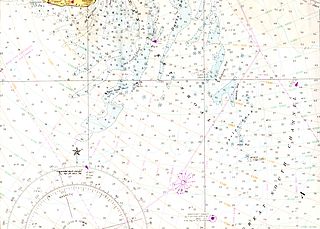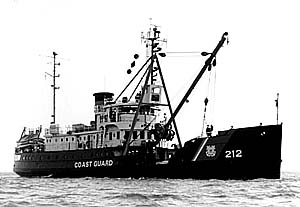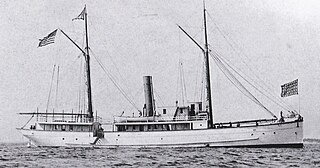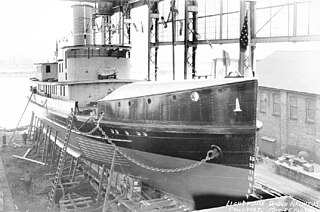
A lightvessel, or lightship, is a ship that acts as a lighthouse. They are used in waters that are too deep or otherwise unsuitable for lighthouse construction. Although some records exist of fire beacons being placed on ships in Roman times, the first modern lightvessel was off the Nore sandbank at the mouth of the River Thames in London, England, placed there by its inventor Robert Hamblin in 1734. The type has become largely obsolete; lighthouses replaced some stations as the construction techniques for lighthouses advanced, while large, automated buoys replaced others.

A. G. Prentiss was the 46 GRT wooden-hulled commercial vessel A. G. Prentiss launched 6 February 1912, by the Charles Ward Shipyard in Kennebunk, Maine, registered with official number 209585, for passenger service with home port at Saco, Maine. The vessel was named for Alfred G. Prentiss, owner of other tugs and a grain and groceries business. Despite the odd registration as "passenger" service when "tow" is one of the options, the vessel was well documented as a tug boat operating on the Saco River in Maine.

The first USS Cassin (DD-43) was the lead ship of Cassin-class destroyers in the United States Navy during World War I. She was later transferred to the United States Coast Guard, where she was designated CG-1. She was named for Stephen Cassin.

The station named Nantucket or Nantucket Shoals was served by a number of lightvessels that marked the hazardous Nantucket Shoals south of Nantucket Island. The vessels, given numbers as their "name," had the station name painted on their hulls when assigned to the station. Several ships have been assigned to the Nantucket Shoals lightship station and have been called Nantucket. It was common for a lightship to be reassigned and then have the new station name painted on the hull. The Nantucket station was a significant US lightship station for transatlantic voyages. Established in 1854, the station marked the limits of the dangerous Nantucket Shoals. She was the last lightship seen by vessels departing the United States, as well as the first beacon seen on approach. The position was 40 miles (64 km) southeast of Nantucket Island, the farthest lightship in North America, and experienced clockwise rotary tidal currents.

USCGC Cowslip (WLB-277) is a 180-foot (55 m) sea going buoy tender (WLB). A Cactus-class vessel, she was built by Marine Ironworks and Shipbuilding Corporation in Duluth, Minnesota. Cowslip's preliminary design was completed by the United States Lighthouse Service and the final design was produced by Marine Iron and Shipbuilding Corporation in Duluth. On 16 September 1941 the keel was laid. She was launched on 11 April 1942 and commissioned on 17 October 1942. The original cost for the hull and machinery was $918,873.
USCGC Spar (WLB-403) was a 180-foot (55 m) sea going buoy tender. An Iris class vessel, she was built by Marine Ironworks and Shipbuilding Corporation in Duluth, Minnesota. Spar's preliminary design was completed by the United States Lighthouse Service and the final design was produced by Marine Iron and Shipbuilding. On 13 September 1943 the keel was laid, she was launched on 2 November 1943 and commissioned on 12 June 1944. The original cost for the hull and machinery was $865,941.

The USCGC Evergreen was a Cactus-class seagoing buoy tender operated by the United States Coast Guard. She served in the North Atlantic during World War II and participated in the International Ice Patrol in these waters after the war. She was the first dedicated oceanographic vessel in the Coast Guard's history. She was decommissioned in 1990 and sunk by the US Navy for target practice in 1992.

The United States Coast Guard Cutter Fir was the last lighthouse tender built specifically for the United States Lighthouse Service to resupply lighthouses and lightships, and to service buoys. Fir was built by the Moore Drydock Company in Oakland, California in 1939. On 22 March 1939, the U.S. Lighthouse Tender Fir was launched. She was steam driven with twin screws, 175 feet (53 m) in length, had a beam of 32 feet (9.8 m), drew 11 feet 3 inches (3.43 m) of water, and displaced 885 tons. Fir was fitted with a reinforced bow and stern, and an ice-belt at her water-line for icebreaking. She was built with classic lines and her spaces were lavishly appointed with mahogany, teak, and brass. The crew did intricate ropework throughout the ship. The cost to build Fir was approximately US$390,000. Fir's homeport was Seattle, Washington for all but one of her fifty one years of service when she was temporarily assigned to Long Beach, California when USCGC Walnut was decommissioned on 1 July 1982.

United States lightship Nantucket (LV-112) is a National Historic Landmark lightship that served at the Lightship Nantucket position. She was the last serving lightship and at time of its application as a landmark, one of only two capable of moving under their own power. She served as the lightship for such notable vessels as the liners United States, Queen Mary, and Normandie.

USRC Levi Woodbury was a Pawtuxet-class screw steam revenue cutter built for the United States Revenue Cutter Service during the American Civil War. Built in 1863–64, she became one of the longest-serving revenue cutters in the Service's history, and was the oldest active-duty ship in U.S. government service by the end of her 51-year career.
The Nantucket Lightship LV58 was a lightvessel of the United States Lighthouse Board from 1894 to 1905. During those years, she primarily served the coast of Fire Island in New York and the Nantucket Shoals, though she was a relief vessel and served as needed in other locations off the northeast coast as well. From 1898 to her sinking in 1905, she was occasionally used as a lighthouse tender.

USLHT Azalea was built as a lighthouse tender and performed in that role on the Massachusetts coast from 1891 to 1917 and again from 1919 to 1933. During World War I, she served in the United States Navy as USS Azalea. Between the wars she was a commercial freighter in Chesapeake Bay, and later between Florida and The Bahamas. During World War II, she was reacquired by the U.S. Navy and served as USS Christiana, a seaplane tender which supported advanced bases in The Bahamas. Declared surplus in 1946, she was sold to Banana Supply Company, and spent a decade transporting bananas from the Caribbean to Miami. After 1956 her history is uncertain until she became a half-sunk derelict and was scrapped in Miami in 1965.

Acushnet – a steel-hulled revenue cutter – was launched on 16 May 1908 at Newport News, Virginia, by the Newport News Shipbuilding and Drydock Co.; sponsored by Miss Alayce Duff; and commissioned at Baltimore on 6 November 1908. She saw service as a United States Revenue Cutter Service cutter, a U.S. Navy fleet tug, and as a U.S. Coast Guard cutter. She was taken out of service 8 January 1946.
USC&GS Drift was a United States Coast Survey schooner built in 1876 specifically to anchor in offshore waters to undertake current measurements. She was transferred to the United States Lighthouse Board on May 20, 1893 to become the lightship Light Vessel # 97 or (LV-97) on the Bush Bluff station until retirement and sale in 1918 to become the W. J. Townsend which was scrapped in 1945.

United States Navy Auxiliary ship Sterling was an iron, schooner-rigged collier in service with the United States Navy from 1898 to 1919. Originally purchased to transport coal for United States Navy ships during the Spanish–American War, she served in that role until sold in 1919. While serving as the Chilean flagged steamer, Llai Llai, she was rammed by a Chilean warship on 11 March 1920 and sank near Iquique, Chile.

USLHT Mangrove was a lighthouse tender in commission in the fleet of the United States Lighthouse Board from December 1897 to April 1898 and from August 1898 to 1910, in the United States Lighthouse Service from 1910 to 1917 and from 1919 to 1939, and in the United States Coast Guard from 1939 to 1941 and in 1946. She also saw commissioned service in the United States Navy as USS Mangrove on three occasions, operating as an armed supply ship from April to August 1898 during the Spanish–American War, during which she fought the last battle of that war; as a patrol vessel from 1917 to 1919 during and in the aftermath of World War I; and as a buoy tender from 1941 to 1946 during and in the aftermath of World War II.

USCGC Ironwood (WAGL-297/WLB-297) was a Mesquite-class sea-going buoy tender operated by the United States Coast Guard. She served in World War II, the Korean War, and the Vietnam War as well as a variety of domestic missions. She currently serves as a seamanship training vessel for Job Corps.

USS YF-445 was a U.S. Navy covered lighter built in 1943 for service in World War II. Her most significant action during the war was to supply ships with food and water at the landing beaches of Operation Dragoon, the allied invasion of Southern France in 1944.

USLHT Zizania was a steel-hulled steamship built as a lighthouse tender in 1888. Over four decades of government service she sailed for the U.S. Lighthouse Service, and the U.S. Navy. She was homeported first in Wilmington, Delaware, and then in Portland, Maine during her Lighthouse Service Years. She served the U.S. Navy in both World War I and World War II. She was renamed during her World War II service, becoming USS Adario, a net tender based at Naval Operating Base Norfolk.

USLHT Arbutus was built as a lighthouse tender for the Massachusetts coast. She served in that role from her launch in 1933 until World War II. In 1939, the Lighthouse Service was merged into the United States Coast Guard and the ship became USCGC Arbutus. During the war she was under United States Navy control. She served as an anti-submarine net-tender at Newport, Rhode Island. After the war she was posted to New York and resumed her buoy tender responsibilities. She was decommissioned in 1967 and sold in 1969.



















